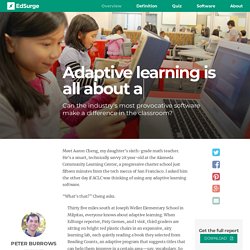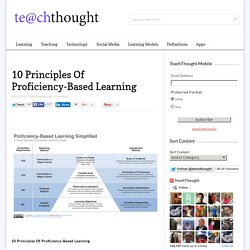

Adaptive Learning. Adaptive learning isall about cont Can the industry's most provocative softwaremake a difference in the classroom?

Meet Aaron Cheng, my daughter’s sixth-grade math teacher. He’s a smart, technically savvy 28 year-old at the Alameda Community Learning Center, a progressive charter school just fifteen minutes from the tech mecca of San Francisco. I asked him the other day if ACLC was thinking of using any adaptive learning software. “What’s that?” Journalist Why is adaptive learning important? 90 sec Thirty five miles south at Joseph Weller Elementary School in Milpitas, everyone knows about adaptive learning. Third-graders from Joseph Weller Elementary School, Milpitas (CA) | Photo Credit: Paty Gomes/EdSurge For us, the decision to use adaptive technology was about helping underachievers catch up. Of the two, Joseph Weller is simultaneously more—and less—like most schools throughout the US.
Changing teaching practices. Well, I’ve only been teaching for three years, so I’d be willing to try. 10 Principles of Proficiency-Based Learning. 10 Principles Of Proficiency-Based Learning by Chris Sturgis 10 Principles Of Proficiency-Based Learning” by Chris Sturgis was originally published on CompetencyWorks.

Great Schools Partnership continues to produce great resources to support states and districts converting to competency education. They have drawn from what districts are doing in New England and have created Proficiency-based Learning Simplified resources. They are a good resource for states, districts and schools to start the conversation about the new policies and practices that need to be put in place. We know that we are on a journey, and its a creative one, so don’t be surprised if you find that you want to take these ideas further or that you come up with other ways to address the policy and practice elements.
Here are GSP’s 10 principles of proficiency-based learning. In practice, proficiency-based learning can take a wide variety of forms from state to state or school to school—there is no universal approach. Here is Everything You Wanted to Know about Micro-Learning. The Power Of Personalization In eLearning. Ask 10 people to order a pizza and you’ll see just how individual we all are and that there are endless ways to create personal savory perfection.

Thin base or thick? Order in or take out? More mozzarella… but hold the anchovies, thanks! Personalization allows us to add a touch of the pizza experience to eLearning through customizing content and features to the learner’s individual needs, preferences, and learning style. Through applying personalization in eLearning, learning content can be presented to the individual rather than the group… and allow everyone to choose their own toppings! At PulseLearning we’ve taken a look at how personalization can create individualized, relatable learning to satisfy a healthy learner appetite: Allow for personal content customization.It’s not just pizza we’re particular about.
Five Research-Driven Education Trends At Work in Classrooms.
Virtual Learning. Student Engagement. Student Centered Learning. STEM. Social & Emotional Learning. SAMR. Robotics. Questioning. Project-Based Learning. PBL 2. PBL 3. Personalized Learning. Multiple Intelligences. Minecraft. Maker. Learner Centered. Inquiry-Based Learning. Interest Based Learning. Integrated Studies. Gradeless. Genius Hour.
Game-Based Learning. Gamification. Games. Games 2. Flipped Learning. Flipped. Discovery Learning. Differentiated Instruction. Design Thinking. Design Learning.
Constructivist Learning. Competency Based Learning. Collaborative / Cooperative Learning. Blended Learning II. Blended Learning. Brain-Based Learning. Bloom's Taxonomy. Authentic Learning. Alternative Assessment. Active Learning. Accountable Talk.